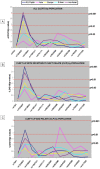Association of AXIN2 with non-syndromic oral clefts in multiple populations
- PMID: 22370446
- PMCID: PMC3327729
- DOI: 10.1177/0022034512440578
Association of AXIN2 with non-syndromic oral clefts in multiple populations
Abstract
We have previously shown the association of AXIN2 with oral clefts in a US population. Here, we expanded our study to explore the association of 11 AXIN2 markers in 682 cleft families from multiple populations. Alleles for each AXIN2 marker were tested for transmission distortion with clefts by means of the Family-based Association Test. We observed an association with SNP rs7224837 and all clefts in the combined populations (p = 0.001), and with SNP rs3923086 and cleft lip and palate in Asian populations (p = 0.004). We confirmed our association findings in an additional 528 cleft families from the United States (p < 0.009). We tested for gene-gene interaction between AXIN2 and additional cleft susceptibility loci. We assessed and detected Axin2 mRNA and protein expression during murine palatogenesis. In addition, we also observed co-localization of Axin2 with Irf6 proteins, particularly in the epithelium. Our results continue to support a role for AXIN2 in the etiology of human clefting. Additional studies should be performed to improve our understanding of the biological mechanisms linking AXIN2 to oral clefts.
Conflict of interest statement
The authors declare no potential conflicts of interest with respect to the authorship and/or publication of this article.
Figures



References
-
- Birnbaum S, Ludwig KU, Reutter H, Herms S, Steffens M, Rubini M, et al. (2009). Key susceptibility locus for nonsyndromic cleft lip with or without cleft palate on chromosome 8q24. Nat Genet 41:473-477 - PubMed
Publication types
MeSH terms
Substances
Grants and funding
LinkOut - more resources
Full Text Sources
Medical
Molecular Biology Databases

